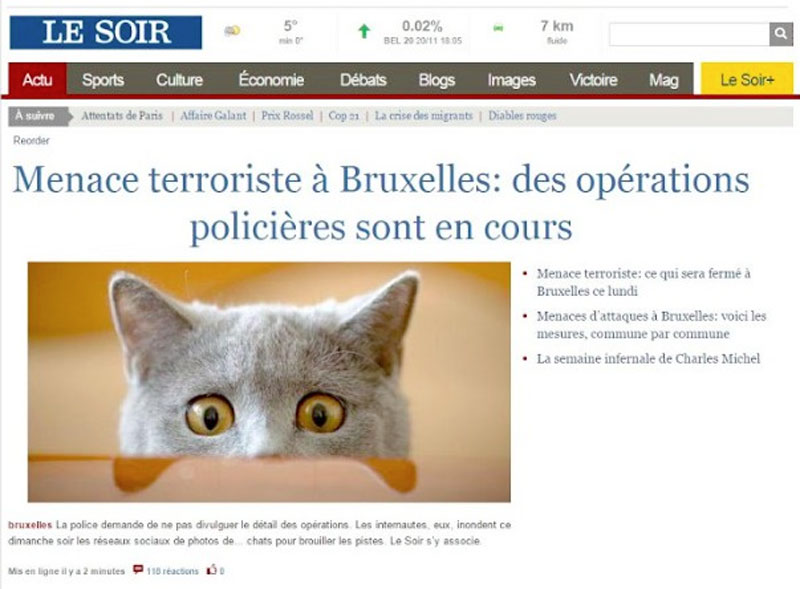Three days after coordinated attacks in Paris killed 130 people last month, the Belgian police launched operations in the Brussels suburb of Molenbeek to locate the suspected planners. They asked residents not to post on social media about the operations.
Instead, Belgians began flooding Twitter with cat photos, using #BrusselsLockdown. The idea was to clog social media so potential terrorists couldn’t use it to track police activity, and to spread a bit of humor during a tense moment. Belgian media referred to the cat photos as a “smokescreen.”
BREAKING NEWS : Belgium Police using the new 200mph Hovercat during terrorist operations #BrusselsLockdown pic.twitter.com/MnIpiOZT3x
— Jayce le Satirique (@jaycelight) November 22, 2015
But it wasn’t just civilians who played along. The press did, too. “As far as I know, all of the media [in Belgium] accepted to be silent during this operation, even netizens and private bloggers,” explains Jean-François Dumont, Deputy Secretary General of the Belgian journalists’ union.
To Dumont and others, abstaining from live reporting was “a natural gesture on the part of the journalists. They agreed to stop coverage out of a sense of responsibility.” In an op-ed following the lockdown, Francis Van de Woestyne, the editor in chief of La Libre, a French-language daily in Belgium, defended the police request and argued for the occasional “necessary opacity” on the part of the press. “Even if it may seem intellectually complicated, the most reasonable thing to do is to trust the country’s authorities,” Van de Woestyne writes, “Because the obsession we must have is the security of the population.”
It’s worth noting that when this all happened, Brussels was on high alert. In the days following the Paris attacks, the Belgian government said that it had “relatively precise” information about an imminent attack in the city. Shops were shuttered, concerts and sporting events were cancelled, the metro was closed, and masked soldiers roamed the streets with automatic weapons.

Le Soir, one of Belgium’s two main French-language dailies, led its coverage of the lockdown with a cat photo on its homepage. The headline reads: “Terrorist threat in Brussels: police operations are underway.”
Yet Twitter has become an essential tool for covering police operations, especially in urban settings. And it wasn’t just social media that went dark, but more traditional kinds of reporting as well. One reporter from Liberation, the French daily, joked on Twitter the following day that all the journalists in the center of Brussels were working next to the police and army, but instead of questioning officials, were only asking one another for information.
¨After the police request, everyone [in the Belgian press] abdicated their jobs,” says Yves Desmet, a reporter for De Morgen, one of Belgium’s largest Dutch-language newspapers.
“Everyone followed the authorities blindly. Everything the police asked, we did as Belgians.”
Dyab Abou Jahjah, a columnist with De Standaard, a Dutch-language daily newspaper in Belgium, was among the few who defied the police directive. He lives in Molenbeek and was at home during one of the raids. The neighborhood was tense, he says, and many had the sense that a massive police operation was going on, despite the lack of information. After watching soldiers in the street point their weapons at an oncoming car, causing the driver to swerve and crash, he took to Twitter.
In my street now: Army and police blocking the way. Pointing guns at citizens in cars. Helecopters hovering. Extremely edgy. #Brussels
— Dyab Abou Jahjah (@Aboujahjah) November 22, 2015
The reaction was instantaneous. Dozens of people responded, many in anger, calling on him to respect the police request and not post about the event. “I had the whole country turning against me as a traitor,” he says.
@Aboujahjah There is supposed to be a media blackout on this operation, called for by the police, you could be endangering lives
— Emma Thompson (@CynicallyScribe) November 22, 2015
@Aboujahjah DO NOT TWEET POSITIONS!!
— Gauri Khandekar (@KhandekarGauri) November 22, 2015
@Aboujahjah the police asks to stop tweeting on the operation!
— Miri Bdel (@MiriBdel) November 22, 2015
By the end of the day, police had arrested 16 people, all but one of whom were quickly released. They found no weapons or explosives.
Yves Desmet argues that the raids were mainly a show of force, especially in Molenbeek, the neighborhood where the Paris attacks had been planned under the radar of the Belgian police and intelligence services. But because of the lockdown, he says, there was no way to assess the actual threat in Brussels or whether or not the government measures were appropriate, nor did journalists discuss what had provoked raising the national threat alert level and its subsequent lowering days later.
Desmet also cites cases of warrantless searches and racial profiling that went largely undocumented. ¨For me, the cat photos were a rather bitter joke,” Desmet says. “It showed how docile and uncritical we were at that time.”
Abou Jahjah says the cat meme shows how many in Belgium missed the bigger picture.
“Police were here with an attitude as if everyone is a potential terrorist,” he says of the raids in his neighborhood, one of Brussels’ main immigrant areas. Instead of demanding accountability, Belgians “resign[ed] from their role as a citizen and as a critical voice, to let the police do the job. It’s like they said, ‘Whatever the police tell us, we’ll follow them.’ ”
After the onslaught of messages on Twitter, Abou Jahjah received a comment from the official account of the Belgian Federal Police. They asked him, publicly and in English: “Freedom of speech vs safety of people. What’s more important?”
@krisvdc @Aboujahjah Freedom of speech vs safety of people. What’s most important?
— Federale Politie (@FedPol_pers) November 22, 2015
The next day, Abou Jahjah says, he received a call from the Federal Police spokesperson apologizing for singling him out online. “The police were under pressure,” the spokesperson told him, “and they made mistakes.”
Zach Campbell is a reporter based in Barcelona. Follow him on Twitter @notzachcampbell

